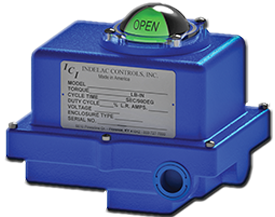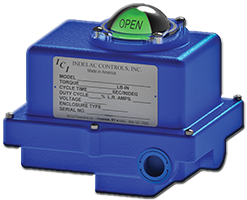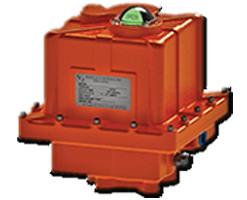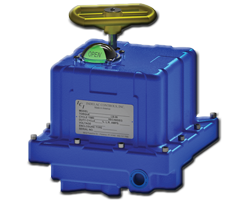In process applications, adjusting the position of valves and dampers to control the flow is an essential part of day-to-day operations. However, in large industrial facilities, the manual operation of these valves can be time-consuming and impractical.
Valve actuators are used to mechanically adjust valve positioning throughout an entire process or facility from a remote location such as a control room. Electric actuators are machines that convert electrical energy into a specific physical motion in order to automate manual valve or damper functions to increase process complexity and efficiency.
The types of motion produced by an electric actuator:
Thrust (linear motion in a fixed plane)
- Capacity of a linear actuator to perform work can be measured in the amount of thrust it can generate. This is measured in Pounds of Thrust in the U.S. or, Newton’s (N) internationally.
- Speed of a linear actuator is measured in Inches per Minute (in/min) in the U.S. or, Meters per Minute (m/min) internationally.
- The length of the linear motion is also a crucial element.
Rotation (revolution around a fixed axis)
- Capacity of a rotary actuator to perform work can be measured by the amount of torque it can generate. Torque is measured by Inch Pounds (In-lbs.) or Foot Pounds (ft.-lbs.) in the U.S. and Newton Meters (Nm) internationally.
- Speed of a rotary actuator is measured in Degrees per Second (deg./s) or Rotations per Minute (rpm) in the U.S. and Meters per Minute (m/min) internationally.
- The degrees of rotation or number of overall turns are also a crucial element.
Electric actuators achieve motion through the operation of a combination of structural components such as gears, bearings, electric motors, and shafts. These elements can be adjusted via electrical or mechanical sensors through simple controls or via PLC for complete control of motion profiles that can be used to regulate or throttle valve output flow.
Types of Electric Actuators
Although all electric actuators work via electrical energy, their driving force can differ depending on the valve type and application. Most electric actuators can be classified as solenoid or motor-driven. Solenoid actuators produce a magnetic field when energized with electricity to drive the actuator motion, whereas motor-driven actuators induce movement via AC or DC current applied to an electric motor. Indelac manufactures motor-driven electric actuators.
Quarter Turn Electric Rotary Actuators
Quarter turn electric rotary actuators use electrical energy to open or close valves and dampers through a 90o motion (or a quarter turn). Quarter turn valves and dampers are some of the easiest to automate, and are used in approximately 80% of industrial applications. An electrical signal is sent to the motor, which drives rotational movement to the desired position. Indelac quarter turn electric actuators are available in both AC and DC voltages with 10 different available power options, capable of delivering torques ranging from 100in-lbs. through 27,300in-lbs.
Electric actuators that produce quarter turn movements are used in a wide range of industries for precise positioning of rotary valves such as ball valves, plug valves, choke valves, butterfly valves, and dump valves. These actuators can also be used in air/fluid dampening applications.
One of the variations of the quarter turn electric actuator includes an internal battery backup. These types of actuators operate on the same principle, except a fail-safe battery backup unit is added to supply electricity to the actuator in the event of power failure. This actuator is ideal for power critical applications and can be configured to fail open, fail closed, or continue standard operations.
Spring Return Electric Rotary Actuators
Spring return electric actuators can be used in both linear and rotary valve applications. The main operating principle involves using the energized actuator to oppose the motion of a spring, resulting in a buildup of potential energy. Upon de-energization (loss of utility power), the potential energy in the spring is released, instantly sending the valve to its fail position (fail closed & fail open options are available). These valve actuators are used in critical automation applications where fail-safe functionality is required. Indelac quarter turn electric actuators are available in both AC and DC voltages with 5 different available power options, capable of delivering torques ranging from 200in-lbs. through 1,200in-lbs.
Benefit of a spring return electric actuator over other types of fail-safe solutions:
- No regular maintenance required.
- Upon loss of power, fail-safe position is achieved in 1 to 3 sec. depending on torque requirements.
- Fail-safe functionality is mechanical and utilizes kinetic energy.
Spring return electric actuators can be used in various commercial and industrial applications automating dampers as well as rotary valves including ball valves, butterfly valves, plug valves, choke valves, and dump valves.
Multi-turn Electric Rotary Actuators
Multi-turn electric rotary actuators are used to automate rotary valves that require more than one revolution. These valves can include plug valves, choke valves, gate valves, knife gate valves, sluice gate valves, diaphragm valves and needle valves. Similar to quarter-turn valves, an electric gear motor is used to provide multiple turns in speeds ranging from ¼ rpm to 3 rpm. These actuators are also available in different sizes, for various torque requirements, and are available in both AC and DC voltages.
Electric Linear Actuators
Electric linear actuators use electrical energy to produce linear movement, which regulates valve or damper position and thus flow.
The ball screw linear actuator converts rotary motion into linear movement by circulating ball bearings along a threaded shaft. As the balls move along the shaft within a ball nut, linear motion is induced in the screw shaft.
A lead screw converts rotary motion into linear motion by combining a screw and a nut where the screw thread is in direct contact with the nut thread. Lead screws are not as efficient as ball screws are, but they are resistant to back driving.
Electric linear actuators are used to automate linear valves, including globe valves, gate valves, knife gate valves, sluice gate valves, needle valves and diaphragm valves. Additional uses may also involve fluid dampers and door locks.
Indelac’s Electric Actuators
At Indelac Controls Inc. (ICI), we supply a wide variety of electric actuators to suit numerous operating conditions. Our heavy-duty NEMA-4, NEMA-4X and NEMA-7 approved enclosures guarantee safe operation in highly corrosive and flammable environments.
ICI’s electric actuators feature:
|
|
|
All of ICI’s electric actuators have been designed with the best manufacturing practices and highest quality construction materials to achieve an optimal balance of cost-effectiveness, durability, and functionality.
If you would like to learn more about our electric actuators or our other products and services, feel free to contact us or request a quote.











